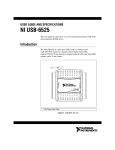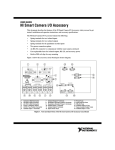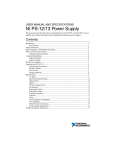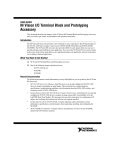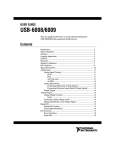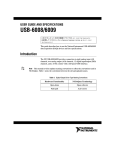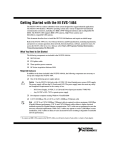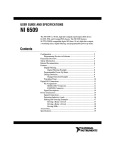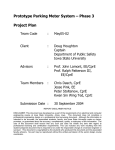Download National Instruments USB-6501 OEM Computer Drive User Manual
Transcript
USER GUIDE USB-6501 OEM This user guide describes how to use the National Instruments USB-6501 OEM data acquisition (DAQ) device. The NI USB-6501 OEM is a full-speed USB 2.0 device that provides 24 DIO channels and a 32-bit counter. Dimensional Drawings Figure 1 shows a top view of the USB-6501 OEM. Figure 2 shows the front and rear dimensions. 0.45 in. (11.5 mm) 0.18 in. (4.5 mm) –0.03 in. (–0.8 mm) –0.18 in. (–4.6 mm) 2.26 in. (57.4 mm) 1.78 in. (45.2 mm) 1.61 in. (40.8 mm) 1.45 in. (36.7 mm) 1.37 in. (34.7 mm) 0.89 in. (22.7 mm) 0.125 in. (3.18 mm) Diameter 2.13 in. (54.1 mm) 1.13 in. (28.7 mm) 0.48 in. (12.2 mm) 0.00 in. (0.0 mm) 0.00 in. (0.0 mm) 0.33 in. (8.3 mm) 0.13 in. (3.3 mm) 2.65 in. (67.3 mm) 2.41 in. (61.2 mm) 2.04 in. (51.8 mm) 1.66 in. (42.2 mm) Figure 1. USB-6501 OEM Dimensions (Top View) Pin 1 0.45 in. (11.5 mm) 0.25 in. (6.4 mm) 0.34 in. (8.6 mm) 0.06 in. (1.6 mm) Figure 2. USB-6501 OEM Dimensions (Front and Rear Views) Block Diagram Figure 3 shows key functional components of the USB-6501 OEM device. +5 V Vbus P2.<0..7> USB Microcontroller USB P1.<0..7> P0.<0..7> Digital I/O Terminal Block Full-Speed USB Interface Short Circuit Protection Current Limiting Circuit Figure 3. Device Block Diagram Refer to the Safety Guidelines section of this document for important safety information. Installing Software To install the driver software for the USB-6501 OEM device, go to ni.com/downloads, click the Drivers and Updates link, and select Multifunction DAQ from the Product Line drop-down list. Next, select the appropriate software, software version, and operating system. USB-6501 OEM User Guide 2 ni.com I/O Connector and Cable Use any 34-pin female IDC (ribbon) cable to connect to the IDC connector on the USB-6501 OEM device. Table 1 lists the pin assignments and signal names for the IDC connector. Table 1. Pin Assignments Signal Pin Connector Pin Signal P1.0 1 2 GND P1.1 3 4 P2.0 P1.2 5 6 GND P1.3 7 8 P2.1 P1.4 9 10 GND P1.5 11 12 P2.2 P1.6 13 14 GND P1.7 15 16 P2.3 P0.0 17 18 GND P0.1 19 20 P2.4 P0.2 21 22 GND P0.3 23 24 P2.5 P0.4 25 26 GND P0.5 27 28 P2.6 P0.6 29 30 GND P0.7 31 32 P2.7 +5V 33 34 +5V © National Instruments Corporation Pin 1 Pin 2 Pin 33 Pin 34 3 USB-6501 OEM User Guide Signal Descriptions Table 2 describes the signals available on the I/O connectors. Table 2. Signal Descriptions Signal Name Direction Description P0.<0..7> P1.<0..7> P2.<0..6> Input or Output Digital I/O Signals—You can individually configure each signal as an input or output. P2.7 (CTR 0 SRC) Input or Output This pin is configurable as either a digital line or an event counter. Digital I/O Signal—As a digital line, this signal can be used as an input or output. CTR—As a counter, this signal can be used as an event counter input source. +5 V Output +5 V—The voltage source provided by the USB host. The voltage is nominally 5 V, but varies from system to system. GND — Ground—The reference for the digital signals and the +5 VDC supply. Digital I/O The USB-6501 OEM has 24 single-ended digital lines, P0.<0..7>, P1.<0..7>, and P2.<0..7>, which comprise the three DIO ports. P2.7 can also function as a 32-bit counter. Refer to the Event Counter section for more information about the counter. Static DIO Each of the USB-6501 OEM DIO lines can be individually programmed as a static DI or DO line. You can use static DIO lines to monitor or control digital signals. All samples of static DI lines and updates of DO lines are software-timed. Source/Sink Information The default configuration of the USB-6501 OEM DIO ports is open-drain, allowing 5 V operation, with an onboard 4.7 kΩ pull-up resistor. An external, user-provided, pull-up resistor can be added to increase the source current drive up to a 8.5 mA limit per line, as shown in Figure 4. USB-6501 OEM User Guide 4 ni.com USB-6501 OEM DIO Box Short Circuit Protection Current Limiting Circuit +5 V Re VBus Rp 4.7K Onboard Resistor External Pull-up Resistor Port Pad P0.0 Rl Load GND A Figure 4. Example of Connecting External User-Provided Resistor Complete the following steps to determine the value of the user-provided pull-up resistor: 1. Place an ammeter in series with the load. 2. Place a variable resistor between the digital output line and the +5 V. 3. Adjust the variable resistor until the ammeter current reads as the intended current. The intended current must be less than 8.5 mA. 4. Remove the ammeter and variable resistor from your circuit. 5. Measure the resistance of the variable resistor. The measured resistance is the ideal value of the pull-up resistor. 6. Select a static resistor value for your pull-up resistor that is greater than or equal to the ideal resistance. 7. Reconnect the load circuit and the pull-up resistor. Additionally, you can configure the USB-6501 OEM DIO ports as push-pull. Digital I/O Circuitry Figure 5 shows P0.<0..7> connected to example signals configured as digital inputs and digital outputs. You can configure P1.<0..7> and P2.<0..7> similarly. Refer to Figure 4 for some common examples of connections of DIO lines with standard circuits. © National Instruments Corporation 5 USB-6501 OEM User Guide +5 V 1 LED P0.0 P0.1 P0.2 P0.3 P0.4 P0.5 P0.6 P0.7 LED 2 3 +5 V TTL Signal 4 Switch GND I/O Connector 1 2 3 4 P0.0 configured as an open-drain digital output driving a LED P0.2 configured as a push-pull digital output driving a LED P0.4 configured as a digital input receiving a TTL signal from a gated inverter P0.7 configured as a digital input receiving a 0 V or 5 V signal from a switch Figure 5. Example of Connecting a Load Exceeding the maximum input voltage ratings or maximum output ratings, which are listed in the Specifications section, can damage the DAQ device and the computer. National Instruments is not liable for any damage resulting from such signal connections. Caution I/O Protection Each DIO signal is protected against overvoltage, undervoltage, and overcurrent conditions, as well as ESD events. However, you should avoid these fault conditions by using the following guidelines: USB-6501 OEM User Guide • If you configure a DIO line as an output, do not connect it to any external signal source, ground signal, or power supply. • If you configure a DIO line as an output, understand the current requirements of the load connected to these signals. Do not exceed the specified current output limits of the DAQ device. • If you configure a DIO line as an input, do not drive the line with voltages outside of its normal operating range. • Treat the DAQ device as you would treat any static sensitive device. Always properly ground yourself and the equipment when handling the DAQ device or connecting to it. 6 ni.com Power-On States At system startup and reset, the hardware sets all DIO lines to high-impedance inputs. The DAQ device does not drive the signal high or low. Each line has a weak pull-up resistor connected to it. Event Counter You can configure P2.7 as the source for a 32-bit counter. In this mode, the device counts high to low transitions on P2.7. The counter can be armed and disarmed and the count can be read or reset through software. Refer to your software documentation for more information about counter programming techniques. +5 V Power Source When using the 5 V source, understand the current requirements of the load connected. Do not exceed the specified current output limits of the USB Vbus. Caution The USB-6501 OEM supplies a nominal 5 V from two pins on the front IDC connector. The voltage source is provided by the USB host. The voltage is nominally 5 V, but varies from system to system. Refer to the Specifications section for more information about USB bus power specifications. This source can be used to power external components. Note While the device is in USB suspend, the output is disabled. Specifications The following specifications are typical at 25 °C, unless otherwise noted. Digital I/O Number of lines P0.<0..7>......................................... 8 P1.<0..7>......................................... 8 P2.<0..7>......................................... 8 Direction control .................................... Input or output, software-selectable Output driver type .................................. Push-pull or open-drain, software selectable © National Instruments Corporation 7 USB-6501 OEM User Guide Pull-up resistor........................................4.7 kΩ VBus (nominally 5 V) Absolute voltage range ...........................–0.5 to 5.8 V with respect to GND Power-on state ........................................Input (high impedance) Digital logic levels Level Input Input low voltage Input high voltage Input leakage current Output Output low voltage (I = 8.5 mA) Output high voltage Push-pull, I = –8.5 mA Open-drain, I = –0.6 mA, nominal Open-drain, I = –8.5 mA, with external pull-up resistor Min Max Units –0.3 2.0 — 0.8 5.8 50 V V µA — 0.8 V 2.0 2.0 2.0 3.5 5.0 — V V V Counter Number of counters ................................1 (P2.7 can be configured as a counter) Resolution ...............................................32 bits Counter measurements ...........................Falling edge counting Maximum input frequency .....................5 MHz Minimum high pulse width.....................100 ns Minimum low pulse width......................100 ns Bus Interface USB specification ...................................USB 2.0 full-speed (12 Mb/s) External Voltage +5 V output Voltage ............................................4.10 V min, 5.25 V max Current.............................................230 mA max USB-6501 OEM User Guide 8 ni.com Power Requirements USB 4.10 to 5.25 VDC ............................ 80 mA typical, 500 mA max USB Suspend .................................. 300 µA standby mode, 500 µA max Physical Characteristics Dimensions ............................................ 5.74 cm × 6.73 cm × 1.15 cm (2.26 in. × 2.65 in. × 0.45 in.) I/O connectors ........................................ USB series B receptacle; 34-pin IDC ribbon cable header Weight .................................................... 21 g (.74 oz) Safety Standards The USB-6501 is designed to meet the requirements of the following standards of safety for electrical equipment for measurement, control, and laboratory use: • IEC 61010-1, EN 61010-1 • UL 61010-1 • CAN/CSA-C22.2 No. 61010-1 Note For UL and other safety certifications, refer to the product label, or visit ni.com/certification, search by model number or product line, and click the appropriate link in the Certification column. Overvoltage Protection Connect only voltages that are within these limits. Channel-to-COM (one channel)............. ±30 V max, Measurement Category I Channels-to-COM (one port, all channels)........................... ±8.9 V max, Measurement Category I Measurement Category I is for measurements performed on circuits not directly connected to the electrical distribution system referred to as MAINS voltage. MAINS is a hazardous live electrical supply system that powers equipment. This category is for measurements of voltages from © National Instruments Corporation 9 USB-6501 OEM User Guide specially protected secondary circuits. Such voltage measurements include signal levels, special equipment, limited-energy parts of equipment, circuits powered by regulated low-voltage sources, and electronics. Do not use this module for connection to signals or for measurements within Measurement Categories II, III, or IV. Caution Hazardous Locations The USB-6501 is not certified for use in hazardous locations. Environmental The USB-6501 device is intended for indoor use only. Operating temperature (IEC 60068-2-1 and IEC 60068-2-2)......0 to 55 °C Operating humidity (IEC 60068-2-56) ...................................10 to 90% RH, noncondensing Maximum altitude...................................2,000 m (at 25 °C ambient temperature) Storage temperature (IEC 60068-2-1 and IEC 60068-2-2)......–40 to 85 °C Storage humidity (IEC 60068-2-56) ..................................5 to 90% RH, noncondensing Pollution Degree (IEC 60664) ................2 EMC/EMI ...............................................CE, C-Tick, and FCC Part 15 (Class A) Compliant CE Compliance The USB-6501 OEM device is intended to be used as part of a system. To ensure that your system meets the appropriate CE Compliance regulations, you must test the entire system. This product meets the essential requirements of applicable European Directives, as amended for CE marking, as follows: Low-Voltage Directive (safety)..............73/23/EEC Electromagnetic Compatibility Directive (EMC) .....................................89/336/EEC USB-6501 OEM User Guide 10 ni.com Refer to the Declaration of Conformity (DoC) for this product for any additional regulatory compliance information. To obtain the DoC for this product, visit ni.com/certification, search by model number or product line, and click the appropriate link in the Certification column. Note Safety Guidelines Caution Operate the hardware only as described in these operating instructions. The following section contains important safety information that you must follow when installing and using the USB-6501 OEM device. Do not operate the USB-6501 OEM device in a manner not specified in this document. Misuse of the device can result in a hazard. You can compromise the safety protection built into the device if the device is damaged in any way. If the device is damaged, contact National Instruments for repair. Do not substitute parts or modify the device except as described in this document. Use the device only with the chassis, modules, accessories, and cables specified in the installation instructions. You must have all covers and filler panels installed during operation of the device. Do not operate the device in an explosive atmosphere or where there may be flammable gases or fumes. If you must operate the device in such an environment, it must be in a suitably rated enclosure. If you need to clean the device, use a dry cloth. Make sure that the device is completely dry and free from contaminants before returning it to service. Operate the device only at or below Pollution Degree 2. Pollution is foreign matter in a solid, liquid, or gaseous state that can reduce dielectric strength or surface resistivity. The following is a description of pollution degrees: • Pollution Degree 1 means no pollution or only dry, nonconductive pollution occurs. The pollution has no influence. • Pollution Degree 2 means that only nonconductive pollution occurs in most cases. Occasionally, however, a temporary conductivity caused by condensation must be expected. • Pollution Degree 3 means that conductive pollution occurs, or dry, nonconductive pollution occurs that becomes conductive due to condensation. You must insulate signal connections for the maximum voltage for which the device is rated. Do not exceed the maximum ratings for the device. Do not install wiring while the device is live with electrical signals. Do not remove or add connector blocks when power is connected to the system. © National Instruments Corporation 11 USB-6501 OEM User Guide Avoid contact between your body and the connector block signal when hot swapping modules. Remove power from signal lines before connecting them to or disconnecting them from the device. Operate the device at or below the Measurement Category I1. Measurement circuits are subjected to working voltages2 and transient stresses (overvoltage) from the circuit to which they are connected during measurement or test. Measurement categories establish standard impulse withstand voltage levels that commonly occur in electrical distribution systems. The following is a description of measurement categories: 1 2 3 • Measurement Category I is for measurements performed on circuits not directly connected to the electrical distribution system referred to as MAINS3 voltage. This category is for measurements of voltages from specially protected secondary circuits. Such voltage measurements include signal levels, special equipment, limited-energy parts of equipment, circuits powered by regulated low-voltage sources, and electronics. • Measurement Category II is for measurements performed on circuits directly connected to the electrical distribution system. This category refers to local-level electrical distribution, such as that provided by a standard wall outlet (for example, 115 V for U.S. or 230 V for Europe). Examples of Measurement Category II are measurements performed on household appliances, portable tools, and similar E Series devices. • Measurement Category III is for measurements performed in the building installation at the distribution level. This category refers to measurements on hard-wired equipment such as equipment in fixed installations, distribution boards, and circuit breakers. Other examples are wiring, including cables, bus-bars, junction boxes, switches, socket-outlets in the fixed installation, and stationary motors with permanent connections to fixed installations. • Measurement Category IV is for measurements performed at the primary electrical supply installation (<1,000 V). Examples include electricity meters and measurements on primary overcurrent protection devices and on ripple control units. Measurement Category as defined in electrical safety standard IEC 61010-1. Measurement Category is also referred to as Installation Category. Working Voltage is the highest rms value of an AC or DC voltage that can occur across any particular insulation. MAINS is defined as a hazardous live electrical supply system that powers equipment. Suitably rated measuring circuits may be connected to the MAINS for measuring purposes. USB-6501 OEM User Guide 12 ni.com Where to Go for Support The National Instruments Web site is your complete resource for technical support. At ni.com/support you have access to everything from troubleshooting and application development self-help resources to email and phone assistance from NI Application Engineers. National Instruments corporate headquarters is located at 11500 North Mopac Expressway, Austin, Texas, 78759-3504. National Instruments also has offices located around the world to help address your support needs. For telephone support in the United States, create your service request at ni.com/support and follow the calling instructions or dial 512 795 8248. For telephone support outside the United States, contact your local branch office: Australia 1800 300 800, Austria 43 0 662 45 79 90 0, Belgium 32 0 2 757 00 20, Brazil 55 11 3262 3599, Canada 800 433 3488, China 86 21 6555 7838, Czech Republic 420 224 235 774, Denmark 45 45 76 26 00, Finland 385 0 9 725 725 11, France 33 0 1 48 14 24 24, Germany 49 0 89 741 31 30, India 91 80 51190000, Israel 972 0 3 6393737, Italy 39 02 413091, Japan 81 3 5472 2970, Korea 82 02 3451 3400, Lebanon 961 0 1 33 28 28, Malaysia 1800 887710, Mexico 01 800 010 0793, Netherlands 31 0 348 433 466, New Zealand 0800 553 322, Norway 47 0 66 90 76 60, Poland 48 22 3390150, Portugal 351 210 311 210, Russia 7 095 783 68 51, Singapore 1800 226 5886, Slovenia 386 3 425 4200, South Africa 27 0 11 805 8197, Spain 34 91 640 0085, Sweden 46 0 8 587 895 00, Switzerland 41 56 200 51 51, Taiwan 886 02 2377 2222, Thailand 662 278 6777, United Kingdom 44 0 1635 523545 National Instruments, NI, ni.com, and LabVIEW are trademarks of National Instruments Corporation. Refer to the Terms of Use section on ni.com/legal for more information about National Instruments trademarks. Other product and company names mentioned herein are trademarks or trade names of their respective companies. For patents covering National Instruments products, refer to the appropriate location: Help»Patents in your software, the patents.txt file on your CD, or ni.com/patents. © 2005 National Instruments Corporation. All rights reserved. 371594A-01 May05













